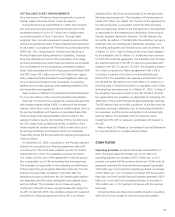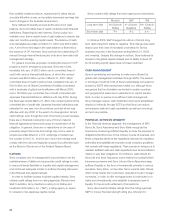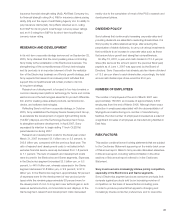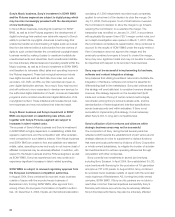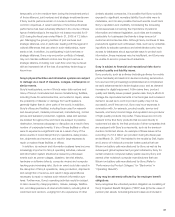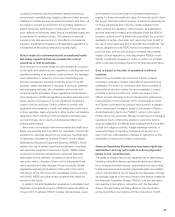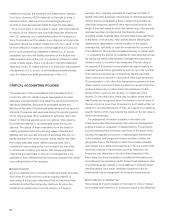Sony 2007 Annual Report Download - page 86
Download and view the complete annual report
Please find page 86 of the 2007 Sony annual report below. You can navigate through the pages in the report by either clicking on the pages listed below, or by using the keyword search tool below to find specific information within the annual report. 83
restructuring initiatives as planned. Therefore, such reorganiza-
tions may not result in improved efficiency, increased ability to
respond to market changes or reallocation of resources to more
profitable activities. The inability to fully and successfully imple-
ment restructuring programs may cause Sony to have insufficient
financial resources to carry out its research and development
plans and to invest in targeted growth business areas.
Foreign exchange rate fluctuations can affect financial
results because a large portion of Sony’s sales and assets
are denominated in currencies other than the yen.
Sony’s consolidated statements of income are prepared from
the local currency-denominated financial results of each of Sony
Corporation’s subsidiaries around the world which are translated
into yen at the monthly average currency exchange rate. Sony’s
consolidated balance sheets are prepared using local currency-
denominated assets and liabilities of each of Sony Corporation’s
subsidiaries around the world, which are translated into yen at
the market exchange rate at the end of each financial period. A
large proportion of Sony’s consolidated financial results, assets
and liabilities is accounted for in currencies other than the
Japanese yen. For example, only 25.6 percent of Sony’s sales
and operating revenue in the fiscal year ended March 31, 2007
were originally recorded in Japan. Accordingly, Sony’s consoli-
dated financial results, assets and liabilities in Sony’s businesses
that operate internationally, principally in its Electronics, Game
and Pictures segments, may be materially affected by changes
in the exchange rates of foreign currencies when translating into
Japanese yen. In the fiscal year ended March 31, 2007, for
example, Sony’s operating income prepared on the basis of U.S.
GAAP in yen decreased from the preceding fiscal year by 68.3
percent to 71.8 billion yen. However, if Sony’s operating income
had been prepared on a local currency basis, it would have
been an operating loss of 20.3 billion yen. Operating results on a
local currency basis described herein reflect sales and operating
revenue and operating income obtained by applying the yen’s
monthly average exchange rate in the previous fiscal year to
local currency-denominated monthly sales, cost of sales, and
selling, general and administrative expenses in the current fiscal
year. Foreign exchange rate fluctuations may have a negative
impact on Sony’s results in the future, especially if the yen
strengthens significantly against the U.S. dollar or the Euro.
Foreign exchange fluctuations can affect Sony’s results of
operations due to sales and expenses in different currencies.
Exchange rate fluctuations affect Sony’s operating profitability
because many of Sony’s products are sold in countries other than
the ones in which they were manufactured. The concentration
of research and development, administrative functions and
manufacturing activities within the Electronics segment largely in
Japan, makes this segment particularly sensitive to the yen’s
appreciation as the ratio of yen-denominated costs to total
costs is higher than the ratio of yen-denominated revenue to
total revenue. Volatile mid- to long-term changes in exchange
rate levels may interfere with Sony’s global allocation of resources
and hinder Sony’s ability to execute procurement, production,
logistics, and sales activities in a manner that is profitable after
the effect of such exchange rate changes.
Although Sony hedges the net foreign currency exposure
resulting from import and export transactions shortly before they
are projected to occur, such hedging activity cannot entirely
eliminate the risk of adverse exchange rate fluctuations.
Sony must efficiently manage its procurement of parts,
the market conditions for which are volatile, and control
its inventory of products and parts, the demand for which
is volatile.
In the Electronics and Game segments, Sony places orders for
components, determines production and plans inventory in
advance based on its forecast of consumer demand, which is
highly volatile and difficult to predict. In the past Sony has
experienced both a shortage of semiconductors, which resulted
in Sony’s inability to meet demand for its PCs and audio visual
products, and a surplus in certain semiconductors that resulted
in the recognition of losses when semiconductor prices fell.
Sony consumes a tremendous volume of parts and components
for its products such as semiconductors and LCD panels.
Consequently, market fluctuations may cause a shortage of
parts and components, and may affect Sony’s production or the
cost of goods sold, as could price fluctuations of the underlying
raw or basic materials. Sony’s profitability may also be adversely
affected by supply or inventory shortages or inventory adjust-
ments that, as a result of efforts to reduce inventory by tempo-
rarily halting production or by reducing the price of goods, will
lead to an increase in the ratio of cost of sales to sales. Sony
writes down the value of its inventory when components or
products have become obsolete, when inventory exceeds the
amount expected to be used, or when the value of the inventory
is otherwise recorded at a higher value than net realizable value.
Such inventory adjustments have had and, if Sony is not success-
ful in managing its inventory in the future, will have a material
adverse effect on Sony’s operating income and profitability.
Sony’s sales and profitability are sensitive to economic and
other trends in Sony’s major markets.
A consumer’s decision to purchase products such as those
offered by Sony in its Electronics, Game and Pictures segments,
as well as by companies within All Other, is to a very significant






